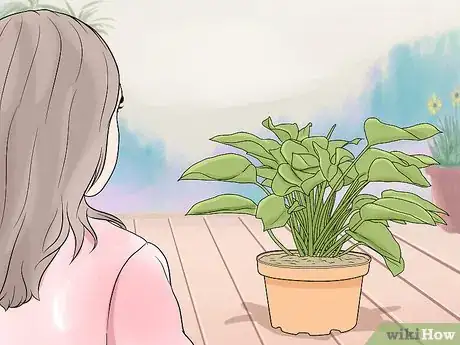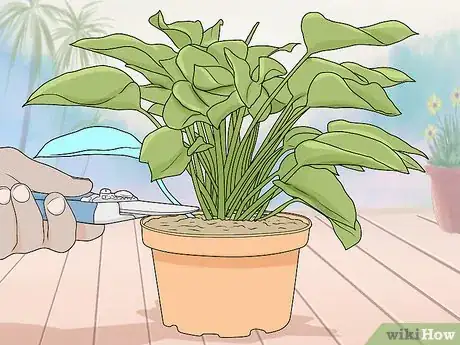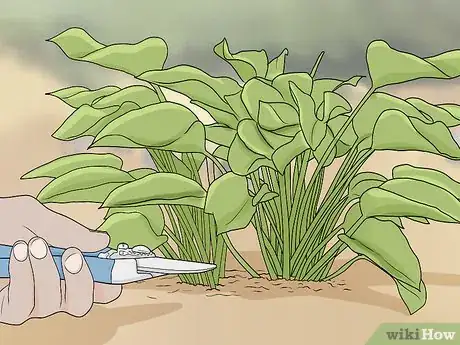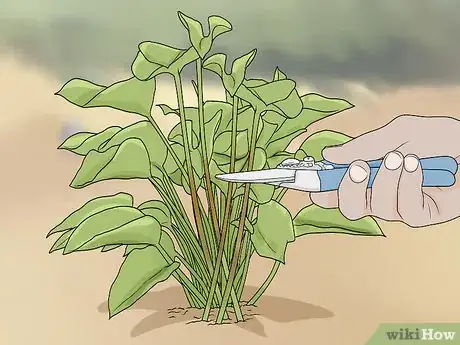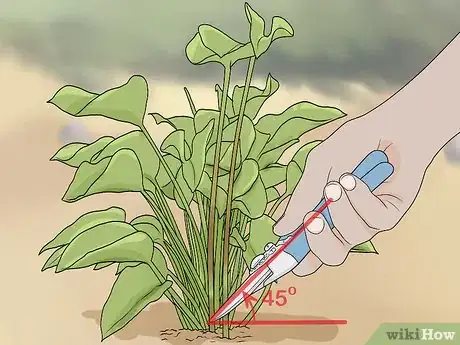This article was co-authored by Lauren Kurtz. Lauren Kurtz is a Naturalist and Horticultural Specialist. Lauren has worked for Aurora, Colorado managing the Water-Wise Garden at Aurora Municipal Center for the Water Conservation Department. She earned a BA in Environmental and Sustainability Studies from Western Michigan University in 2014.
This article has been viewed 51,590 times.
Philodendrons are beautiful plants that need regular maintenance in order to stay healthy. Using sharp scissors or garden shears, you can prune the dead leaves and stems from your plant, and also remove discolored and potentially diseased parts of the philodendron. With regular pruning, your philodendron can bring you joy for many years to come.
Steps
Timing the Pruning
-
1Decide if pruning is necessary. If your philodendron looks healthy, with no dead or discolored leaves and stems, you may not need to prune it at the moment. There is no reason to remove portions of the plant if it is in good shape overall; you can leave it alone and keep an eye on it for any changes.
-
2Prune if there is dead or discolored material. If there are leaves and stems on your plant that are dead or discolored, you'll want to prune your philodendron to remove them. They could stifle the healthy parts of the plant and keep it from growing.
- Discoloration could mean that the plant is diseased in some way. You'll want to remove those areas to keep the disease from spreading. [1]
Advertisement -
3Prune if your philodendron is taking up too much space. The stems of philodendrons will continue to grow, and soon you may find that your plant is too big for the area where you are keeping it. In this case, you can trim the plant to keep it from growing any larger without any harm to the plant. [2]
- Avoid pruning more than ⅓-½ of your philodendron.
-
4Trim the stems that are too long. As your philodendron grows, you'll notice that some stems grow much longer than others. These are typically called "leggy" stems and your plant could look sloppy with a bunch of long, uneven stems sticking out.
- In many cases, a plant is forced to divert more energy to these leggy stems. By keeping everything the same length it will help keep the plant healthier.
- This will also help to encourage new growth, once the leggy stems are removed. [3]
Cutting the Stems
-
1Sterilize your tools. You can use a sharp pair of scissors or gardening shears to prune your philodendron. Before you use one of these, you'll want to soak it in a diluted bleach and water solution, and rinse them very well when you're done. This will keep bacteria from being spread from the tools to the plant. [4]
-
2Cut your plant to preserve as much healthy material as possible. If you're removing dead or diseased portions of the plant, make sure to cut just below the area in question. That way you're not cutting healthy portions of the plant that you want to preserve.
-
3Trim the longest or oldest stems. Holding your tool at a 45-degree angle, cut the longest stems to make them even with the rest of the plant. Your philodendron will look neater, and it will also encourage growth in the rest of the plant.
- Prune your philodendron during active growing periods while the plant is producing new shoots to promote regrowth.
- Wait a few weeks or months after pruning before cutting portions of the plant again. [5]
-
4Prune the philodendron where the stem meets the main plant. In some cases, it will be necessary to remove an entire stem of the plant. Typically, this is because the death or disease has spread, or because you want to thin the plant to make it look better.
- Make sure to leave the main stem alone, the one that connects all of the leaves and stems. Remove only the offshoot branches and stems. [6]
Warnings
- Philodendrons can be toxic to children and pets. Make sure to keep them out of reach at all times.⧼thumbs_response⧽
References
- ↑ https://newengland.com/today/living/gardening/how-to-prune-houseplants/
- ↑ https://hgic.clemson.edu/factsheet/philodendron-pothos-monstera/
- ↑ https://www.bhg.com/gardening/plant-dictionary/houseplant/philodendron/
- ↑ https://newengland.com/today/living/gardening/how-to-prune-houseplants/
- ↑ https://newengland.com/today/living/gardening/how-to-prune-houseplants/
- ↑ https://newengland.com/today/living/gardening/how-to-prune-houseplants/
- ↑ https://www.bhg.com/gardening/plant-dictionary/houseplant/philodendron/
- ↑ https://gardenerdy.com/how-to-grow-care-for-heartleaf-philodendron
